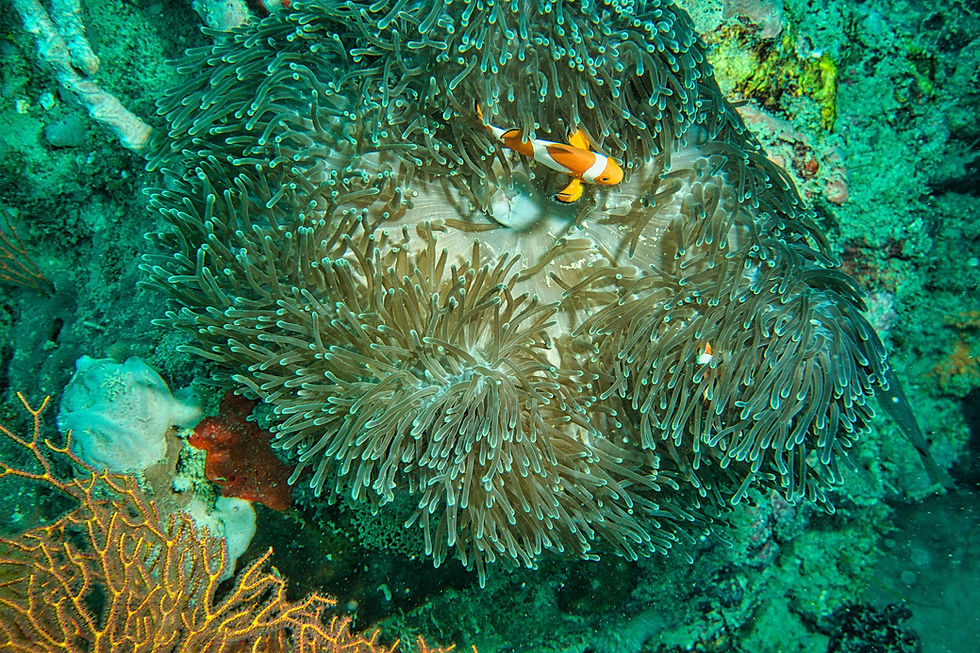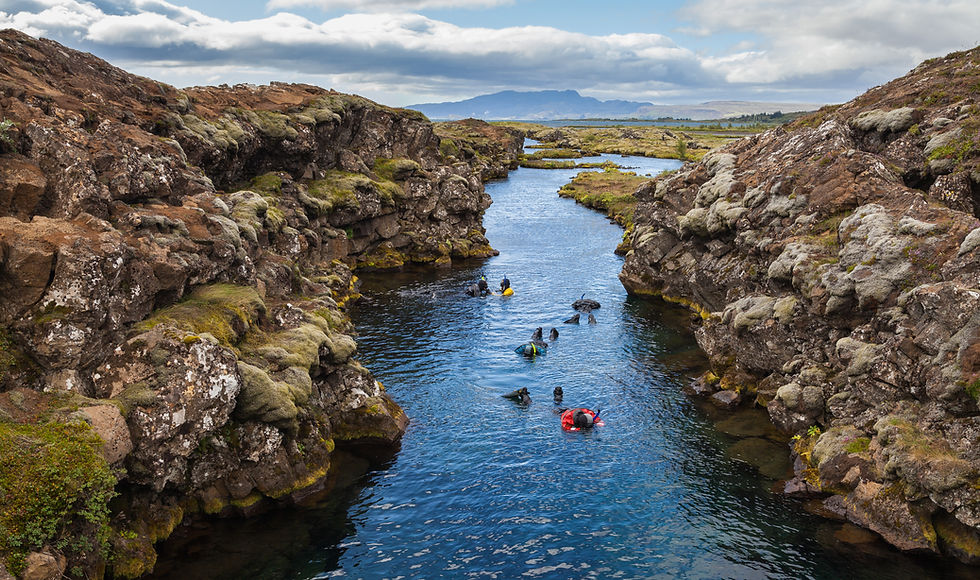The 6 Best Destinations for Freediving
- Kandice Vincent
- Sep 1, 2024
- 7 min read
Updated: Sep 18, 2024
Freediving, the practice of diving on a single breath, provides a unique experience and challenge without the hindrance of bulky scuba gear and without the limitations of snorkeling. The sport is the perfect balance between tranquility and adrenaline as you utilize skillful techniques in order to explore underwater destinations. However, some underwater environments are better suited to freediving than others. In this guide, we explore the six best destinations for freediving, each with unique features, varying depths, and ideal water conditions for exploring with just a freediving mask and some fins.
Cenotes of the Mayan Riviera, Mexico

The Mayan Riviera in Mexico, encompassing the eastern portion of the Yucatán Peninsula along the Caribbean coastline, is full of cenotes that offer freedivers an entirely unique experience. Cenotes are natural sinkholes filled with crystal-clear freshwater formed by the collapse of limestone bedrock. These ancient cenotes were sacred to the Mayan civilization and range in depth from a shallow 32 feet (10 meters) to over 98 feet (30 meters).
Cenote freediving is suitable for all levels. Unlike the open ocean, cenotes have calm and sheltered waters that are free from waves and currents. This provides a safe and predictable environment for beginners to hone their skills and for experienced freedivers to push their limits and practice deep diving techniques.
The freshwater environment offers exceptional water clarity of over 100 feet (30 meters). However, you’ll mostly see geographical features like stalactites and stalagmites, as cenotes are essentially exposed underwater caverns. While there isn’t a huge abundance of marine life in cenotes, you’ll likely see the occasional school of catfish or mojarras, freshwater turtles, and potentially even a crocodile. Some of the most popular cenotes for freediving include Kaan Luum, Maravilla, and Angelita.
Beyond the dive: After your dive, explore the Mayan culture at one of the local archaeological ruins, enjoy delicious Mexican cuisine, and explore the vibrant and lush rainforests of the Yucatán Peninsula.
Blue Hole Diving in The Bahamas

Dean’s Blue Hole in the Bahamas is the world's second-deepest saltwater blue hole, with a depth of about 202 meters (663 feet). While the blue hole itself attracts some of the world’s most advanced freedivers, it is surrounded by a stunning lagoon with shallow, sunlit waters. Freedivers can choose to explore the depths that they are most comfortable with, according to their individual skill level. Regardless of how deep a freediver decides to descend, it’s still a bucket list experience to peer down into the darkness of the hole, where the only light you’ll see is the odd diving light.
It’s recommended that, due to the depth, freedivers be well experienced or visit the blue hole as part of a freediving course, of which many are available out of Clarence Town, the largest settlement on Long Island in the Bahamas.
Due to its depth, marine life is scarce within the hole itself. The majority of notable marine life in and around Dean’s Blue Hole is located around the opening and in shallower regions, where freedivers may encoder schools of jacks, tropical fish, barracuda, and reef and nurse sharks. That said, within the hole, freedivers may experience the unique visual of the thermocline, the distinct layer of cooler water.
Beyond the dive: The Bahamas offers many above-water activities, from relaxing on pristine white sand beaches to exploring vibrant coral reefs on guided snorkeling or scuba diving excursions.
Shipwrecks and Reefs in Indonesia

Indonesia, an archipelago with over 17000 islands, is part of the coral triangle, a marine ecosystem in the western Pacific Ocean that's considered the most biologically complex and diverse in the world. For freedivers looking to see an abundance of live reefs and marine life, Indonesia offers many opportunities. It's also well known for its shipwrecks which are more accessible from the surface than the deeper wrecks in other parts of the ocean.
The Gili Islands, just a short ride from Bali, are known for both these reasons. The lush and shallow coral gardens surrounding the islands are alive with colorful fish like angelfish, butterflyfish, clownfish, and damselfish. The USAT Liberty wreck in Tulamben is located in shallow waters, starting at only 16 feet (5 meters) deep and extending down to 98 feet (30 meters), making it perfect for beginner to advanced freedivers. The wreck itself has become an artificial reef attracting sea turtles, reef sharks, and barracudas.
Additionally, top freediving sites in Indonesia include Raja Ampat, a biodiversity hotspot with exceptional visibility, Bunaken, with a variety of shallow reefs that are ideal for freedivers, and Manta Sandy in Komodo National Park, offering the potential to see manta rays up close.
Beyond the dive: Indonesia also offers tons of other activities, including hiking the volcanoes of Mount Bromo and Mount Rinjani and visiting cultural landmarks like the Borobudur and Prambanan temples.
Witnesses Whales in Sri Lanka

Sri Lanka offers a unique freediving experience with its opportunities to dive with whales, particularly off the coast of Mirissa and Trincomalee. The waters around Sri Lanka are rich in nutrients, which attract a variety of whales, especially during their migratory periods (typically from December to April). Mirissa, located on the southern coast, is the whale-watching capital, where freedivers can arrange private excursions. While the main attraction is the blue whale, you can also see sperm whales, Bryde’s whales, and various species of dolphins. On the northeast coast, Trincomalee is another excellent spot for whale watching, where the deep waters of the Indian Ocean are close to shore, which attracts large marine mammals. The best time to see whales here is from March to August, during the calmer seas of the northeast monsoon.
Freediving with whales requires advanced skills and experience, so it’s essential to be comfortable with deep dives and have good breath-hold capabilities in order to experience the sperm whales fully. However, blue whales can sometimes be spotted nearer to the surface. The keen eye and understanding of whale behavior of the local operators may allow you to experience them without needing to go to extensive depths.
Other great freediving spots in Sri Lanka include Hikkaduwa, known for excellent freediving conditions with clear water and lots of different fish species, and Unawatuna, a coastal town near Galle that is famous for its beaches and underwater scenery.
Beyond the dive: Sri Lanka is a paradise for wildlife enthusiasts, with many opportunities to spot elephants, leopards, and a variety of bird species in national parks like Yala and Udawalawe. The country also has great waves for surfing, with hotspots being Arugam Bay, Hikkaduwa and Weligama.
Explore the Red Sea in Dahab, Egypt

Located on the Sinai Peninsula, along the Red Sea, Dahab offers clear, warm waters and a variety of dive sites, including reefs, canyons, and a blue hole, perfect for freediving. Dahab has near-perfect conditions year-round and calm seas, along with numerous freediving schools with courses catering to all skill levels. The Blue Hole is one of the most famous dive sites in the world, with a maximum depth of over 328 feet (100 meters), providing an ideal setting for deep dives and training for advanced freedivers. Freedivers from around the world come to Dahab to push their limits in the Blue Hole, with a beautiful archway located at about 184 feet (56 meters) in depth.
The Canyon, a unique underwater geological formation, features a long, narrow crack in the seabed where freedivers can explore more shallow sections and observe the unique rock formations. And for those looking for vibrant reefs and marine life that are notorious in the Red Sea, Lighthouse Reef, and Eel Garden are popular areas that are great for all levels, from beginners to experts. Eel Garden is incredibly accessible, and you can snorkel out to the reef right from the shore. When exploring the reefs, you’re likely to encourage lionfish, butterflyfish, triggerfish, pipefish, different kinds of cleaner shrimp, giant moray eels, and seahorses (which the area is famous for).
Beyond the dive: Dahab has a blend of Bedouin culture and laid-back beach vibes. There are many local markets to explore, along with delicious Egyptian cuisine. You can also try your hand at kitesurfing on the Red Sea’s saves, or take day trips to historical sites like Mount Sinai and the St. Catherine's Monastery.
Freedive Between Continents in Iceland

For the super adventurous freediver looking for a truly unique underwater experience, Iceland’s Silfra fissure is a once-in-a-lifetime opportunity. This fissure is a crack formed by the separation of the Eurasian and North American tectonic plates, offering a chance to dive between two continents. The water is fed by glacial meltwater that has been filtered through volcanic rock, making it some of the clearest in the world, with visibility often exceeding 328 feet (100 meters).
While it's suitable for all skill levels, the cold water requires special preparation. The near-freezing water temperatures (35-39°F) require specialized wetsuits and proper training in cold-water diving techniques. You will require full coverage, including a hood, booties, and gloves. There are several tour operators in Iceland that offer guided freediving experience, providing necessary gear, permits and freedive safety briefings. Because of the temperature, don’t expect to see much, if any, marine life, but you’ll have the chance to experience the dramatic rock formations, tunnels and caverns of the underwater landscape.
Beyond the dive: There are tons of outdoor activities to enjoy in Iceland, including exploring the Golden Circle, which includes the stunning Gullfoss waterfall, the Geysir geothermal area, and Thingvellir National Park. If you’re visiting in winter, you’ll also have the opportunity to witness the Northern Lights.
Explore the Best Destinations for Freediving
Each of these destinations offers a unique freediving experience, from the warm, tranquil waters of the Caribbean and Indian Ocean to the breathtaking depths of the world's most renowned blue holes and the landscapes of Iceland's tectonic fissure. Whether you're a beginner looking to explore shallow cenotes or an advanced diver seeking the thrill of deep blue holes and underwater encounters with whales, these locations provide unforgettable underwater adventures.


Transform your images with hidden text using our Text Behind Image tool. Perfect for watermarking, steganography, and creative design. Try it free today!
AV在线看 AV在线看;
自拍流出 自拍流出;
国产视频 国产视频;
日本无码 日本无码;
动漫肉番 动漫肉番;
吃瓜专区 吃瓜专区;
SM调教 SM调教;
ASMR ASMR;
国产探花 国产探花;
强奸乱伦 强奸乱伦;
AV在线看 AV在线看;
自拍流出 自拍流出;
国产视频 国产视频;
日本无码 日本无码;
动漫肉番 动漫肉番;
吃瓜专区 吃瓜专区;
SM调教 SM调教;
ASMR ASMR;
国产探花 国产探花;
强奸乱伦 强奸乱伦;
AV在线看 AV在线看;
自拍流出 自拍流出;
国产视频 国产视频;
日本无码 日本无码;
动漫肉番 动漫肉番;
吃瓜专区 吃瓜专区;
SM调教 SM调教;
ASMR ASMR;
国产探花 国产探花;
强奸乱伦 强奸乱伦;
AV在线看 AV在线看;
自拍流出 自拍流出;
国产视频 国产视频;
日本无码 日本无码;
动漫肉番 动漫肉番;
吃瓜专区 吃瓜专区;
SM调教 SM调教;
ASMR ASMR;
国产探花 国产探花;
强奸乱伦 强奸乱伦;